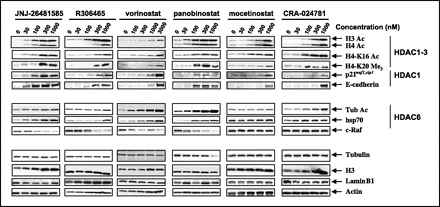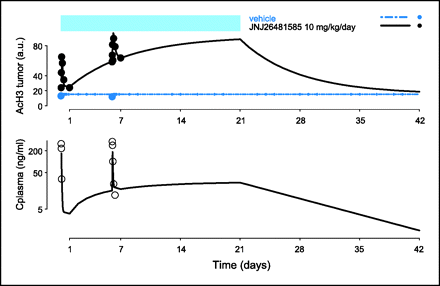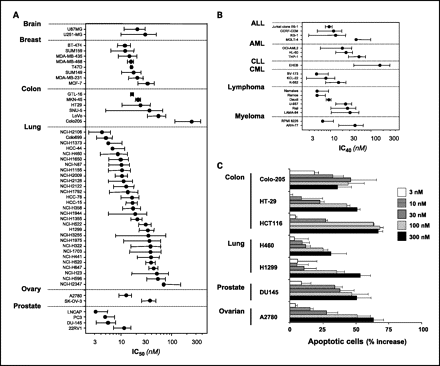
| Size | Price | Stock | Qty |
|---|---|---|---|
| 5mg |
|
||
| 10mg |
|
||
| 25mg |
|
||
| 50mg |
|
||
| 100mg |
|
||
| 250mg |
|
||
| 500mg | |||
| Other Sizes |
Purity: ≥98%
Quisinostat (formerly JNJ26481585) is an orally bioavailable, 2nd generation, hydroxamate-based inhibitor of histone deacetylase (HDAC) with potential anticancer activity. Janssen Pharmaceuticals created it, and NewVac was granted a license to use it for clinical trials. It has an IC50 of 0.11 nM for HDAC1 and inhibits HDAC.
| Targets |
HDAC1 ( IC50 = 0.11 nM ); HDAC2 ( IC50 = 0.33 nM ); HDAC4 ( IC50 = 0.64 nM ); HDAC10 ( IC50 = 0.46 nM ); HDAC11 ( IC50 = 0.37 nM ); HDAC3 ( IC50 = 4.86 nM ); HDAC5 ( IC50 = 3.69 nM ); HDAC8 ( IC50 = 4.26 nM ); HDAC9 ( IC50 = 32.1 nM ); HDAC6 ( IC50 = 76.8 nM ); HDAC7 ( IC50 = 119 nM )
|
||
|---|---|---|---|
| ln Vitro |
|
||
| ln Vivo |
|
||
| Enzyme Assay |
In every instance, Sf9 cells infected with baculovirus are used to express full-length HDAC proteins. Moreover, human NCOR2 and HDAC3 are coexpressed as a complex. HDAC1-containing cellular complexes are measured for activity by incubating immunoprecipitated HDAC1 complexes with an [3H]acetyl-labeled histone H4 peptide fragment [biotin-(6-aminohexanoic)Gly-Ala-(acetyl[3H])Lys-Arg-His-Arg-Lys-Val-NH2] in a total volume of 50μL enzyme assay buffer (25mM HEPES (pH 7.4), 1 M sucrose, 0.1 mg/mL BSA, and 0.01% (v/v) Triton X-100). Immunoprecipitates are incubated for 45 minutes at 37 °C, or 30 minutes at room temperature. HDAC inhibitors are added in increasing concentrations and preincubated for 10 minutes at room temperature prior to the addition of substrate. Following the incubation period, 35μL of stop buffer (1 M HCl and 0.4 M acetic acid) is used to quench the reaction. Using 800μL of ethyl acetate, released [3H]acetic acid is extracted and then measured using scintillation counting. Western blot analysis shows that the immunoprecipitated amounts of HDAC1 are equal. The mean ± SD of three separate experiments on a single lysate are used to present the HDAC1 activity results.
|
||
| Cell Assay |
The American Type Culture Collection is the source of all cell lines, which are cultured in accordance with guidelines. An MTT is used to quantify the impact of HDAC inhibitors on cell proliferation. An Alamar Blue-based assay is used to measure the proliferation of non-small cell lung carcinoma (NSCLC) cell lines. The MTS assay is used to measure the cytotoxic activity of the 72-hour incubation period for hematologic cell lines in order to facilitate their proliferation. At least three independent experiments' mean IC50 or IC40 ± SD are used to present the data.
|
||
| Animal Protocol |
|
||
| References | |||
| Additional Infomation |
N-hydroxy-2-[4-[[(1-methyl-3-indolyl)methylamino]methyl]-1-piperidinyl]-5-pyrimidinecarboxamide is a member of indoles.
Quisinostat has been used in trials studying the treatment of Lymphoma, Neoplasms, Myelodysplastic Syndromes, and Advanced or Refractory Leukemia. Quisinostat is an orally bioavailable, second-generation, hydroxamic acid-based inhibitor of histone deacetylase (HDAC) with potential antineoplastic activity. HDAC inhibitor JNJ-26481585 inhibits HDAC leading to an accumulation of highly acetylated histones, which may result in an induction of chromatin remodeling; inhibition of the transcription of tumor suppressor genes; inhibition of tumor cell division; and the induction of tumor cell apoptosis. HDAC, an enzyme upregulated in many tumor types, deacetylates chromatin histone proteins. Compared to some first generation HDAC inhibitors, JNJ-26481585 may induce superior HSP70 upregulation and bcl-2 downregulation. |
| Molecular Formula |
C21H26N6O2
|
|---|---|
| Molecular Weight |
394.48
|
| Exact Mass |
394.212
|
| Elemental Analysis |
C, 63.94; H, 6.64; N, 21.30; O, 8.11
|
| CAS # |
875320-29-9
|
| Related CAS # |
1083078-98-1 (HCl); 875320-29-9; 875320-31-3 (2HCl)
|
| PubChem CID |
11538455
|
| Appearance |
Off-white to yellow solid powder
|
| Density |
1.358g/cm3
|
| Boiling Point |
615.103ºC at 760 mmHg
|
| Flash Point |
325.803ºC
|
| Index of Refraction |
1.688
|
| LogP |
2.94
|
| Hydrogen Bond Donor Count |
3
|
| Hydrogen Bond Acceptor Count |
6
|
| Rotatable Bond Count |
6
|
| Heavy Atom Count |
29
|
| Complexity |
533
|
| Defined Atom Stereocenter Count |
0
|
| SMILES |
O=C(C1C=NC(N2CCC(CNCC3C4C(=CC=CC=4)N(C)C=3)CC2)=NC=1)NO
|
| InChi Key |
PAWIYAYFNXQGAP-UHFFFAOYSA-N
|
| InChi Code |
InChI=1S/C21H26N6O2/c1-26-14-17(18-4-2-3-5-19(18)26)11-22-10-15-6-8-27(9-7-15)21-23-12-16(13-24-21)20(28)25-29/h2-5,12-15,22,29H,6-11H2,1H3,(H,25,28)
|
| Chemical Name |
N-hydroxy-2-[4-[[(1-methylindol-3-yl)methylamino]methyl]piperidin-1-yl]pyrimidine-5-carboxamide
|
| Synonyms |
JNJ 26481585; JNJ26481585; JNJ-26481585; Quisinostat
|
| HS Tariff Code |
2934.99.9001
|
| Storage |
Powder -20°C 3 years 4°C 2 years In solvent -80°C 6 months -20°C 1 month |
| Shipping Condition |
Room temperature (This product is stable at ambient temperature for a few days during ordinary shipping and time spent in Customs)
|
| Solubility (In Vitro) |
|
|||
|---|---|---|---|---|
| Solubility (In Vivo) |
Solubility in Formulation 1: ≥ 2.5 mg/mL (6.34 mM) (saturation unknown) in 10% DMSO + 40% PEG300 + 5% Tween80 + 45% Saline (add these co-solvents sequentially from left to right, and one by one), clear solution.
For example, if 1 mL of working solution is to be prepared, you can add 100 μL of 25.0 mg/mL clear DMSO stock solution to 400 μL PEG300 and mix evenly; then add 50 μL Tween-80 to the above solution and mix evenly; then add 450 μL normal saline to adjust the volume to 1 mL. Preparation of saline: Dissolve 0.9 g of sodium chloride in 100 mL ddH₂ O to obtain a clear solution. Solubility in Formulation 2: ≥ 2.5 mg/mL (6.34 mM) (saturation unknown) in 10% DMSO + 90% (20% SBE-β-CD in Saline) (add these co-solvents sequentially from left to right, and one by one), clear solution. For example, if 1 mL of working solution is to be prepared, you can add 100 μL of 25.0 mg/mL clear DMSO stock solution to 900 μL of 20% SBE-β-CD physiological saline solution and mix evenly. Preparation of 20% SBE-β-CD in Saline (4°C,1 week): Dissolve 2 g SBE-β-CD in 10 mL saline to obtain a clear solution. View More
Solubility in Formulation 3: ≥ 2.5 mg/mL (6.34 mM) (saturation unknown) in 10% DMSO + 90% Corn Oil (add these co-solvents sequentially from left to right, and one by one), clear solution. |
| Preparing Stock Solutions | 1 mg | 5 mg | 10 mg | |
| 1 mM | 2.5350 mL | 12.6749 mL | 25.3498 mL | |
| 5 mM | 0.5070 mL | 2.5350 mL | 5.0700 mL | |
| 10 mM | 0.2535 mL | 1.2675 mL | 2.5350 mL |
*Note: Please select an appropriate solvent for the preparation of stock solution based on your experiment needs. For most products, DMSO can be used for preparing stock solutions (e.g. 5 mM, 10 mM, or 20 mM concentration); some products with high aqueous solubility may be dissolved in water directly. Solubility information is available at the above Solubility Data section. Once the stock solution is prepared, aliquot it to routine usage volumes and store at -20°C or -80°C. Avoid repeated freeze and thaw cycles.
Calculation results
Working concentration: mg/mL;
Method for preparing DMSO stock solution: mg drug pre-dissolved in μL DMSO (stock solution concentration mg/mL). Please contact us first if the concentration exceeds the DMSO solubility of the batch of drug.
Method for preparing in vivo formulation::Take μL DMSO stock solution, next add μL PEG300, mix and clarify, next addμL Tween 80, mix and clarify, next add μL ddH2O,mix and clarify.
(1) Please be sure that the solution is clear before the addition of next solvent. Dissolution methods like vortex, ultrasound or warming and heat may be used to aid dissolving.
(2) Be sure to add the solvent(s) in order.
| NCT Number | Recruitment | interventions | Conditions | Sponsor/Collaborators | Start Date | Phases |
| NCT02948075 | Completed | Drug: Quisinostat Drug: Paclitaxel |
Ovarian Cancer | NewVac LLC | September 2015 | Phase 2 |
| NCT01486277 | Completed | Drug: Quisinostat, 12 mg | Lymphoma, T-Cell, Cutaneous | Janssen Research & Development, LLC |
November 2011 | Phase 2 |
| NCT02728492 | Completed | Drug: Quisinostat Drug: Paclitaxel |
Non-small Cell Lung Cancer Epithelial Ovarian Cancer |
NewVac LLC | August 2013 | Phase 1 |
| NCT00677105 | Completed | Drug: JNJ-26481585 | Lymphoma Neoplasms |
Johnson & Johnson Pharmaceutical Research & Development, L.L.C. |
August 2007 | Phase 1 |
| NCT01464112 | Completed | Drug: JNJ-2641585 / VELCADE / Dexamethasone |
Multiple Myeloma | Janssen Research & Development, LLC |
September 16, 2011 | Phase 1 |
 |
  |